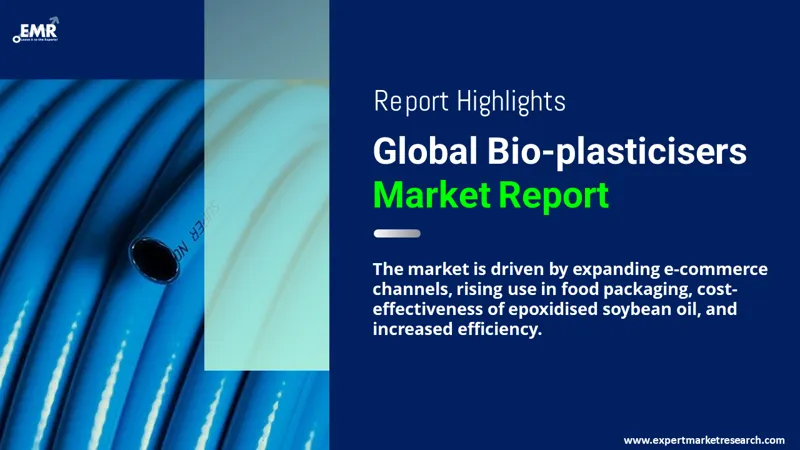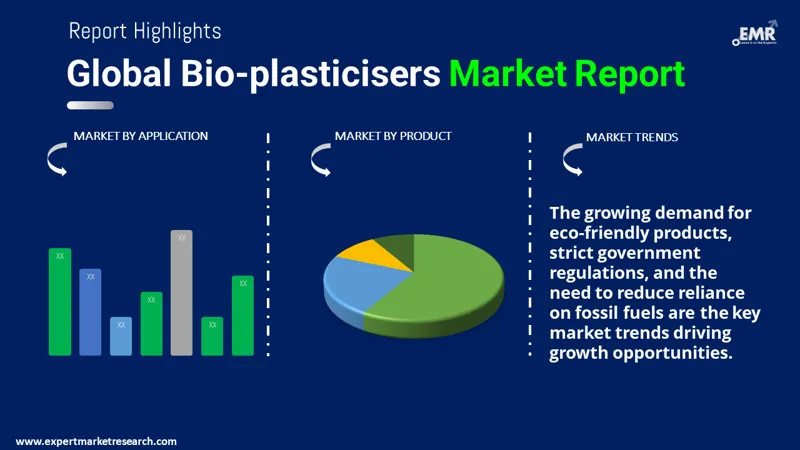
Consumer Insights
Uncover trends and behaviors shaping consumer choices today
Procurement Insights
Optimize your sourcing strategy with key market data
Industry Stats
Stay ahead with the latest trends and market analysis.
Trending Now



The global bio-plasticisers market reached a value of USD 1.53 billion in 2024. The market is further estimated to grow at a CAGR of 5.7% during 2025-2034 to reach a value of USD 2.52 billion in 2034.
Base Year
Historical Year
Forecast Year






| Global Bio-plasticisers Market Report Summary | Description | Value |
| Base Year | USD Billion | 2023 |
| Historical Period | USD Billion | 2018-2024 |
| Forecast Period | USD Billion | 2025-2034 |
| Market Size 2024 | USD Billion | 1.53 |
| Market Size 2034 | USD Billion | 2.52 |
| CAGR 2018-2024 | Percentage | XX% |
| CAGR 2025-2034 | Percentage | 5.7% |
| CAGR 2025-2034 - Market by Region | Latin America | 5.4% |
| CAGR 2025-2034 - Market by Country | Brazil | 6.2% |
| CAGR 2025-2034 - Market by Country | USA | 4.6% |
| CAGR 2025-2034 - Market by Product | Castor Oil-Based Plasticisers | 6.5% |
| CAGR 2025-2034 - Market by Application | Packaging Materials | 6.3% |
| Market Share by Country | France | 3.4% |

Read more about this report - REQUEST FREE SAMPLE COPY IN PDF
Bio-plasticisers are safe and sustainable materials that are used to turn stiff synthetic polymers, such as PVC into soft resins for various applications that demand flexibility. These plasticisers are digestible and are extensively used as an alternative to conventional plasticisers, such as phthalates without any alteration in processing. Factors such as these bolster the bio-plasticisers demand growth over the forecast period.
Increased efficiency, escalating eco-consciousness, stringent government regulations, and the rising need to reduce the dependency on fossil fuels shape the bio-plasticisers market dynamics and trends.
April 2021
BASF introduced the bio-plasticisers, such as Hexamoll DINCH BMB and Palatinol 10-P BMB made of organic waste or vegetable oils for the polyvinyl chloride industry.
Multiple advantages of bio-plasticisers
The bio-plasticisers offer multiple advantages, such as superior technical and processing characteristics, enhanced flexibility, improved chemical properties of plastic products, and oil resistance, among others. Such energy efficiency provided by the bio-plasticisers is a key trend of the bio-plasticisers market.
Rising eco-consciousness
The surging eco-consciousness and the growing awareness about the harmful impacts of conventional plasticisers on the environment are leading to the increased use of bio-plasticisers.
Reducing the dependency on fossil fuels
The emerging need to reduce the dependency on fossil fuels is leading to the replacement of conventional petroleum-based phthalate plasticisers with bio-plasticisers.
Strict government regulations
There are stringent government regulations, such as the ban on fossil fuel-made conventional plasticisers to reduce the environmental impacts and to ensure the safe packaging of food products, affecting the bio-plasticisers market opportunities.
Availability of Different Types of Eco-friendly Plasticisers to Aid the Bio-plasticisers Market
Epoxidized soybean oil is a nontoxic and yellow-coloured liquid, which is developed from soybean oil through the process of epoxidation. Epoxidized soybean oil is easily available, renewable, and cost-effective, thus resulting in its wider utilisation across various end-use sectors.
The castor-oil-based bio-plasticisers are extensively used in various natural and synthetic resins, like polyvinyl chloride, nitrocellulose, ethylcellulose, and rubber polymers for improved elongation. They provide superior electrical insulating properties, excellent lubricity, cold-crack resistance, and improved heat stability.
Citrate plasticisers provide an improved toxicological profile and are compatible with various polymers, which leads to their increasing use as an alternative to phthalate plasticisers in different technical applications. There is expanding availability of non-VOC citric bio-plasticisers that are approved for food contacts and are used in interior applications where no emission is required, augmenting the bio-plasticisers industry growth.
There is an increasing demand for succinate acid-made plasticisers of average molecular weight owing to their reduced viscosity, enhanced paste stability, and low-temperature flexibility in synthetic polymer compounds. The market players are making strong efforts to offer plasticisers made from succinic acid, a naturally occurring substance as they have a reduced environmental footprint when compared to adipic acid-based plasticisers.
Rising Production of Bio-Plastics Globally Supports the Demand for Bio Plasticisers
According to European Bioplastics e.V., worldwide production capacity of bioplastics is expected to increase significantly between 2022 and 2028 due to the increasing demand for sustainable alternatives. In 2022, the total production capacity for all types of bioplastics stood at 1,813 thousand tonnes, wherein 949 thousand tonnes were biobased/non-biodegradable and 864 thousand tonnes were biodegradable. This capacity is likely to reach 7,432 thousand tonnes by the year 2028, where biodegradable is foreseen to reach 4,605 thousand tonnes and biobased/non-biodegradable would be 2,827 thousand tonnes.
The total production capacity for bioplastics was 1,813 thousand tonnes in 2022, of which 1,507 thousand tonnes were used, meaning a capacity utilisation of 83%. By 2023, production reached 1,799 thousand tonnes while capacity utilisation was 82% of the extended capacity at 2,182 thousand tonnes. This small reduction in capacity utilisation from 83% down to 82% shows that production is increasing, but not with the same speed as capacity extension, leading onto new trends of the bio-plasticisers market.
In 2023, the total production capacity for bioplastics reached 2,182 thousand tonnes, with 52.1% for fully biodegradable bioplastics and the remaining 47.9% accounted for biobased/non-biodegradable bioplastics. Correspondingly, PLA makes up 31.0% of the entire capacity, while SCPC-or starch/cellulose-based plastics-makes up 6.4%, and PBAT-or polybutylene adipate terephthalate-4.6%. Other less important biodegradable bioplastics include PHA at 4.8% and PBS at 0.9%.
For the biobased/non-biodegradable bioplastics, PA polyamides leads the way at 18.3%, followed by PTT polytrimethylene terephthalate at 13.5%, PE polyethylene at 12.3%, while PET polyethylene terephthalate stands at 2.2%. Other bioplastics cumulatively makeup 1.1%. The growth in capacity for bioplastic production reflects progress in bio-based material technology to make durable bioplastic possible. As production of bioplastics goes up, demand for bio plasticisers, without which one cannot achieve elasticity and resistance within a bioplastic, is growing accordingly.

Read more about this report - REQUEST FREE SAMPLE COPY IN PDF
“Bio-plasticisers Market Report and Forecast 2025-2034” offers a detailed analysis of the market based on the following segments:
On the basis of products, the market can be divided into:
| CAGR 2025-2034 - Market by | Product |
| Castor Oil-Based Plasticisers | 6.5% |
| Succinic Acid | 6.2% |
| Epoxidised Soybean Oil (ESBO) | XX% |
| Citrates | XX% |
| Others | XX% |
On the basis of application, the market can be segmented into:
| CAGR 2025-2034 - Market by | Application |
| Packaging Materials | 6.3% |
| Consumer Goods | 6.1% |
| Automotive and Transport | 5.9% |
| Building and Construction | XX% |
| Textiles | XX% |
| Others | XX% |
On the basis of region, the market can be divided into:
| CAGR 2025-2034 - Market by | Region |
| Latin America | 5.4% |
| North America | 4.7% |
| Europe | XX% |
| Asia Pacific | XX% |
| Middle East and Africa | XX% |
| CAGR 2025-2034 - Market by | Country |
| Brazil | 6.2% |
| Australia | 5.0% |
| USA | 4.6% |
| Japan | 4.4% |
| Germany | 4.2% |
| Canada | XX% |
| UK | XX% |
| France | XX% |
| Italy | 3.6% |
| China | XX% |
| India | XX% |
| Saudi Arabia | XX% |
| Mexico | XX% |
Rising Utilisation in the Packaging Sector to Support the Bio-plasticisers Market Expansion
The expanding e-commerce channels owing to advantages, like convenience, are leading to the increasing use of bio-plasticisers in the packaging sector, particularly in the case of food products. The stringent regulations regarding the safe packaging of food items are resulting in the application of non-toxic bio-plasticisers as they do not have an impact on the taste of packaged food. Also, the lightweight bio-plasticisers result in the reduced use of fuel during transportation, thus being economical and reducing the environmental footprint.
As per bio-plasticisers industry analysis, the bio-plasticisers are extensively used as additives in consumer goods, such as cosmetics, to provide a smooth texture. Also, there is expanding use of bio-plasticisers in the production of consumer goods, such as toys, to obtain more flexibility and address the growing safety concerns. The increasing production of automobiles due to improved living standards and the surging demand for environment-friendly vehicles are leading to the increasing use of bio-plasticisers in automotive production. Also, automobile producers are adopting bio-plasticisers to reduce the dependency on fossil fuels.
The increasing construction of buildings owing to rapid urbanisation is leading to the growing use of bio-plasticisers in cement mortar mixes to reduce viscosity and boost performance with more flexibility.
The bio-plasticisers industry in the Asia-Pacific region will gain the maximum demand. This demand will be driven by fast industrialization, growing consumer awareness related to sustainability, and tough environmental regulations in countries such as China, India, and Japan. Further investments in green technologies and expansion of the manufacturing sectors increase the consumption of bio-plasticisers. In addition, growing disposable incomes and changing lifestyles result in greater focus on eco-friendly products. Hence, the Asia-Pacific region is considered a significant growth region for the bio-plasticisers industry.
| Market Share by | Country |
| France | 3% |
| USA | XX% |
| Canada | XX% |
| UK | XX% |
The strong presence of market players and their efforts to launch superior quality bio-plasticisers that meet customer expectations support the market growth.
Evonik Industries AG, founded in 2007 and headquartered in Essen, Germany, this specialty chemicals manufacturer maintains 27 production plants in over 100 countries worldwide. Its five key divisions are specialty additives, performance materials, nutrition and care, smart materials, and technology and infrastructure.
BASF SE, founded in 1865 in Ludwigshafen, Germany, manufactures chemicals, materials, industrial solutions, surface technologies, nutrition, care, and agriculture. The company is listed on the Frankfurt Stock Exchange, and its listings are under the symbol BAS, while its operations are run in more than 90 countries of the world.
Solvay S.A., founded in 1863 and headquartered in Brussels, Belgium, hhas been a leading chemical company whose solutions contribute to making a safer and more sustainable future. The company focuses on innovations across various industries to make them more sustainable.
Other key players profiles in the bio-plasticisers industry report include Lanxess AG, and Vertellus Specialties Inc., among others.
*While we strive to always give you current and accurate information, the numbers depicted on the website are indicative and may differ from the actual numbers in the main report. At Expert Market Research, we aim to bring you the latest insights and trends in the market. Using our analyses and forecasts, stakeholders can understand the market dynamics, navigate challenges, and capitalize on opportunities to make data-driven strategic decisions.*
Get in touch with us for a customized solution tailored to your unique requirements and save upto 35%!
In 2024, the market attained a value of nearly USD 1.53 billion.
The market drivers include expanding e-commerce channels, rising use in food packaging, cost-effectiveness of epoxidized soybean oil, and increased efficiency.
The market is estimated to witness a healthy growth in the forecast period of 2025-2034 to reach almost USD 2.52 billion by 2034.
The key market trends creating growth opportunities include the escalating eco-consciousness, stringent government regulations, and rising need to reduce the dependency on fossil fuels.
The significant products considered in the market are epoxidized soybean oil (ESBO), castor oil-based plasticisers, citrates, and succinic acid, among others.
The different applications are packaging materials, consumer goods, automotive and transport, building and construction, textiles, and agriculture and horticulture, among others.
The market is assessed to grow at a CAGR of 5.7% between 2025 and 2034.
The major players in the market are Evonik Industries AG, BASF SE, Lanxess AG, Vertellus Specialties Inc., and Solvay S.A., among others.
Explore our key highlights of the report and gain a concise overview of key findings, trends, and actionable insights that will empower your strategic decisions.
| REPORT FEATURES | DETAILS |
| Base Year | 2024 |
| Historical Period | 2018-2024 |
| Forecast Period | 2025-2034 |
| Scope of the Report |
Historical and Forecast Trends, Industry Drivers and Constraints, Historical and Forecast Market Analysis by Segment:
|
| Breakup by Product |
|
| Breakup by Application |
|
| Breakup by Region |
|
| Market Dynamics |
|
| Competitive Landscape |
|
| Companies Covered |
|
Datasheet
One User
USD 2,499
USD 2,249
tax inclusive*
Single User License
One User
USD 3,999
USD 3,599
tax inclusive*
Five User License
Five User
USD 4,999
USD 4,249
tax inclusive*
Corporate License
Unlimited Users
USD 5,999
USD 5,099
tax inclusive*
*Please note that the prices mentioned below are starting prices for each bundle type. Kindly contact our team for further details.*
Flash Bundle
Small Business Bundle
Growth Bundle
Enterprise Bundle
*Please note that the prices mentioned below are starting prices for each bundle type. Kindly contact our team for further details.*
Flash Bundle
Number of Reports: 3
20%
tax inclusive*
Small Business Bundle
Number of Reports: 5
25%
tax inclusive*
Growth Bundle
Number of Reports: 8
30%
tax inclusive*
Enterprise Bundle
Number of Reports: 10
35%
tax inclusive*
How To Order
Our step-by-step guide will help you select, purchase, and access your reports swiftly, ensuring you get the information that drives your decisions, right when you need it.

Select License Type
Choose the right license for your needs and access rights.

Click on ‘Buy Now’
Add the report to your cart with one click and proceed to register.

Select Mode of Payment
Choose a payment option for a secure checkout. You will be redirected accordingly.
Gain insights to stay ahead and seize opportunities.

Get insights & trends for a competitive edge.

Track prices with detailed trend reports.

Analyse trade data for supply chain insights.

Leverage cost reports for smart savings

Enhance supply chain with partnerships.

Connect For More Information
Our expert team of analysts will offer full support and resolve any queries regarding the report, before and after the purchase.
Our expert team of analysts will offer full support and resolve any queries regarding the report, before and after the purchase.
We employ meticulous research methods, blending advanced analytics and expert insights to deliver accurate, actionable industry intelligence, staying ahead of competitors.
Our skilled analysts offer unparalleled competitive advantage with detailed insights on current and emerging markets, ensuring your strategic edge.
We offer an in-depth yet simplified presentation of industry insights and analysis to meet your specific requirements effectively.



Australia
63 Fiona Drive, Tamworth, NSW
+61-448-061-727
India
C130 Sector 2 Noida, Uttar Pradesh 201301
+91-723-689-1189
Philippines
40th Floor, PBCom Tower, 6795 Ayala Avenue Cor V.A Rufino St. Makati City,1226.
+63-287-899-028, +63-967-048-3306
United Kingdom
6 Gardner Place, Becketts Close, Feltham TW14 0BX, Greater London
+44-753-713-2163
United States
30 North Gould Street, Sheridan, WY 82801
+1-415-325-5166
Vietnam
193/26/4 St.no.6, Ward Binh Hung Hoa, Binh Tan District, Ho Chi Minh City
+84-865-399-124
United States (Head Office)
30 North Gould Street, Sheridan, WY 82801
+1-415-325-5166
Australia
63 Fiona Drive, Tamworth, NSW
+61-448-061-727
India
C130 Sector 2 Noida, Uttar Pradesh 201301
+91-723-689-1189
Philippines
40th Floor, PBCom Tower, 6795 Ayala Avenue Cor V.A Rufino St. Makati City, 1226.
+63-287-899-028, +63-967-048-3306
United Kingdom
6 Gardner Place, Becketts Close, Feltham TW14 0BX, Greater London
+44-753-713-2163
Vietnam
193/26/4 St.no.6, Ward Binh Hung Hoa, Binh Tan District, Ho Chi Minh City
+84-865-399-124
Share